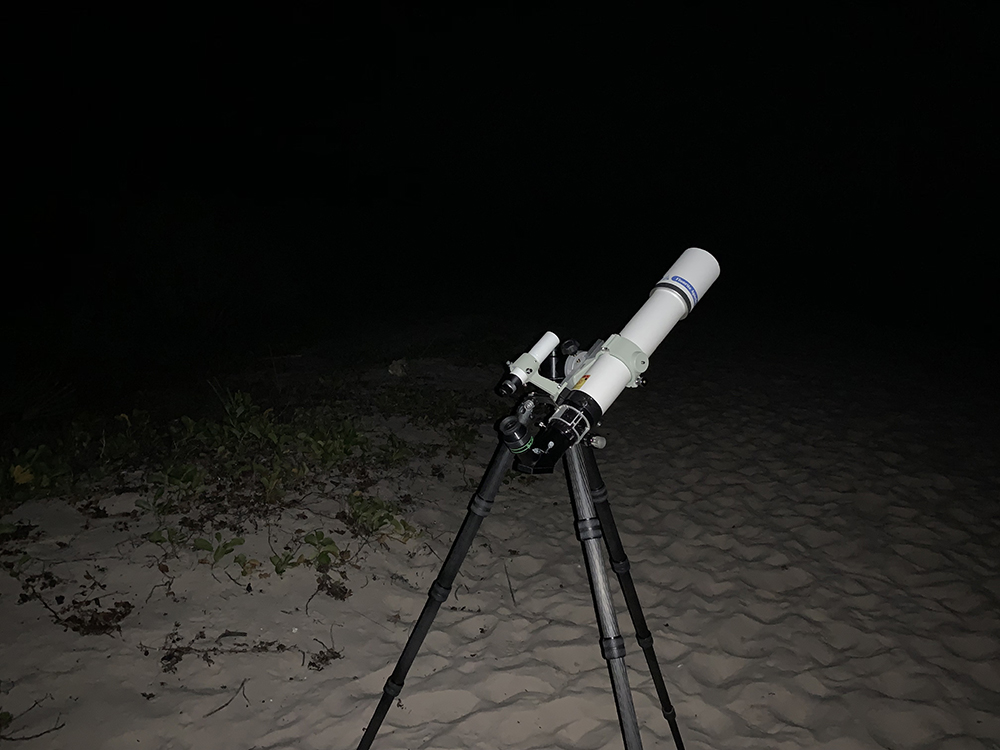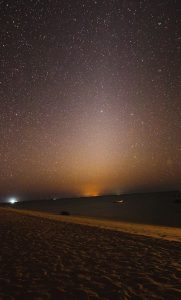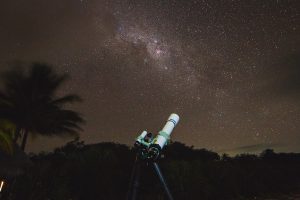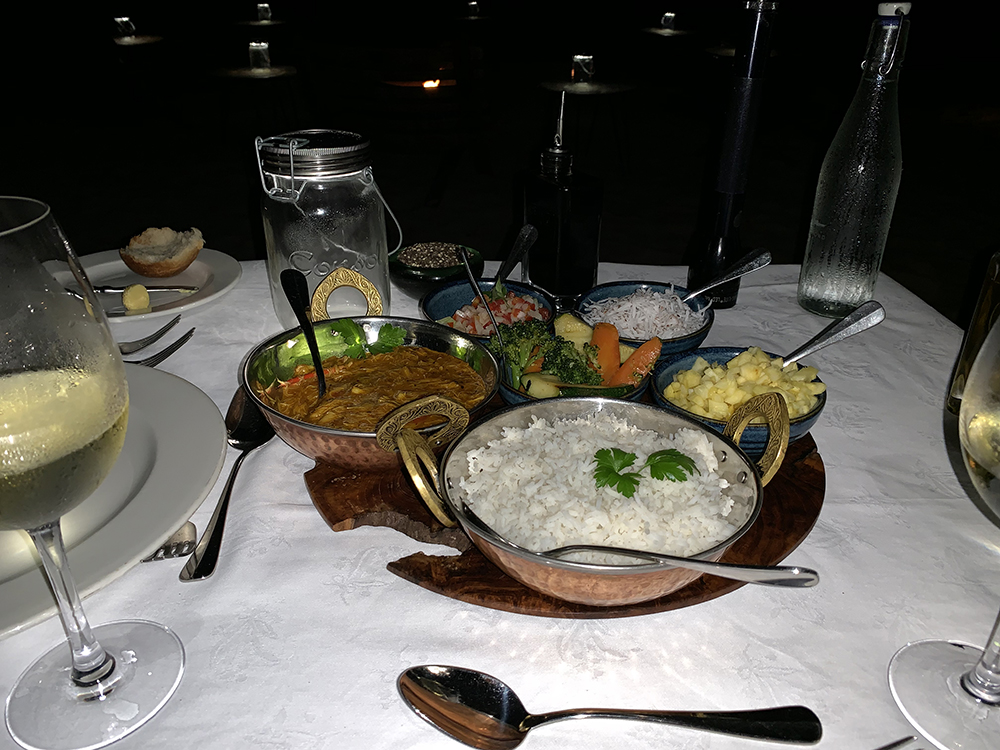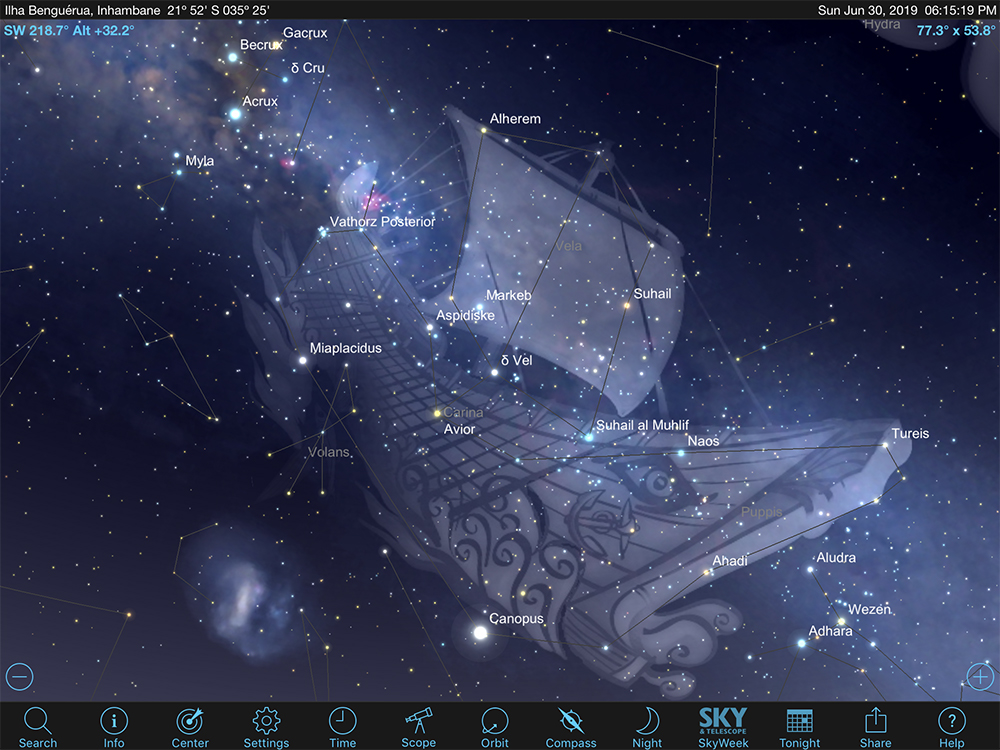
The ancient constellation of Argo Navis was broken up due to its size in 1763. It is an area of the sky every amateur astronomer needs to explore, given it is so rich with DSOs. Source: SkySafari 5 Pro
Perhaps familiarity does breed contempt. Having been fortunate enough to spend the equivalent of a couple of months stargazing from the Southern Hemisphere over the last 7 years, I have come to the conclusion that the southern skies contain a treasure trove of DSOs which exceeds that of our northern heavens. Certainly, we can be jealous of our southern-sky-watching cousins as due to the latitudes of the landmasses south of equator, they also get access to much of our prime night sky as well.
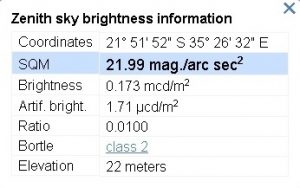
The estimated night sky conditions for Beguerra Island outside our villa. Source: Lightpollutionmap.info.
Travelling south of the equator for holiday once again in July, I made sure to explore as much of the hidden regions as possible during our two-week stay on Benguerra Island in Mozambique. Located 15km off the south east coast in the Indian Ocean, there is little development in the vicinity which results in a Bortle Class 2 sky with a limiting magnitude of +7. We arrived a few days before New Moon, so my first early evening stargazing session was focused on the region of the sky in the west which included the wonderful Carina region of the Milky Way. It was very much a voyage of discovery with Jason, aboard his vessel Argo Navis, the ancient and massive constellation that Nicolas Louis de Lacaille decide to break it up in 1763 due to its unwieldy size (25% greater in area than Hydra).
Travel and weight restrictions meant I was only able to bring my three inch Takahashi FC-76 doublet refractor and four eyepieces, the Tele Vue 24mm Panoptic (24x, 2.7o field), 10mm Radian (57x, 1.1o), 7mm Nagler Type 6 (81x, 0.98o), and the 3-6mm Nagler Zoom (95x-190x, 0.51o-0.26o). However, under skies that dark, that is quite enough aperture to deliver a memorable stargazing experience.
Observing Session
After watching the sunset just after 5pm, I returned to the beach, scope in hand at 6pm, a few minutes after nautical dusk. Despite a deep blue sky, the carina region of the Milky Way was already rather obvious, and the first hints of a soon to be annoyingly bright zodiacal light was appearing on the western horizon. I had hoped to observe two of my favourite open clusters simultaneously in a lower power field, M46 and M47, but sadly at only about 10o altitude, they were grazing against palm trees further down the beach and I was unable to get clean sight of them.
However, another of Messier’s open clusters was not yet lost behind tropical foliage and I panned the scope to Tureis (Rho Puppis) at the tip of the poop deck of Jason’s vessel Argo, before sliding south east around 4 degrees to Asmidiske (Xi Puppis). Placing Xi on the edge of the 24mm brought M93 into view. While this cluster has about 80 members, it creates the illusion of being a far denser cluster, as it lies on the bright Milky Way, so the tiny pearls of the cluster appear to sit on top of even smaller jewels. At 24x, two of the cluster members appeared to have a subtle topaz hue. Taking the power up to 81x expanded the cluster and revealed a distinct triangular shape, almost like the head of an arrow about 10 arcminutes on the long axis, while surrounded by delicate halo of background stars.
Returning to Tureis, I panned about 17o to Naos (Zeta Puppis), a blue supergiant of spectral class O5 Ia, which is the rarest and hottest of all normally classified stars. Almost a thousand light years away, this star shines with an apparent magnitude of +2.25, and is visually 8,000 times more luminous than the Sun. However, with a surface temperature of 42,000K, most of its radiation is emitted in the UV and hence its true bolometric luminosity is greater than 360,000 Suns. I found the star to be a dazzling electric blue distraction and quite beautiful. One could almost imagine celestial moths being drawn to its intoxicating light. Placing Naos near the edge of my 8-degree finder, centred my next target, NGC 2546 in the field of my 24mm Panoptic. At a diameter of 70 arcminutes, this was the only eyepiece I had that would provide clear sky so I could trace out its full extent. The cluster was quite loose with streamers of tiny stars radiating away from two brighter stars on opposite edges of the cluster.
Staying with the 24mm, I placed Naos at the top of the field which brought a Puppis and b Puppis into view, forming an isosceles triangle. Just to the west of b Puppis is Caldwell 71 (NGC 2477). At 57x, the cluster is truly spectacular. Hundreds of cluster members are superimposed on the back ground Milky Way, creating the illusion of finely resolved globular cluster that might be seen with a far larger scope. Multiple strands of stars appear to loop back on themselves. Spending a bit of time with this one, more and more shapes seemed to emerge, unsurprising given the mind’s ability to see patterns where none exist. This cluster reminded me of a spider with its numerous legs in motion as though it was walking across the speckled canvas of the Milky Way. It made think of that most spectacular star forming region, the Tarantula Nebula in the LMC, a target I would need to wait till morning to see.
Less than two degrees to the south is another wonderful, far larger open cluster, NGC 2451. To frame this cluster appropriately, I had to switch back down to the 24mm as it subtends about two full Moon diameters. Far less dense than its nearby sister, what was most striking was the number of colourful stars on show. White diamonds were mixed with blue sapphires and yellow topaz. Rather interestingly, it was discovered about 25 years ago that NGC 2451 is actually two OCs along the same line of sight, with one only 600 light years distant, while the other is double the distance.
Having switched back to the 24mm, both NGC 2477 and 2451 were contained in the same field, and I would argue they present as remarkable a view as M46 and M47, and would be just as famous as their Messier designated cousins if they were slightly further north. It certainly made up for the palm tree hiding the Messier pair from me earlier in the evening.
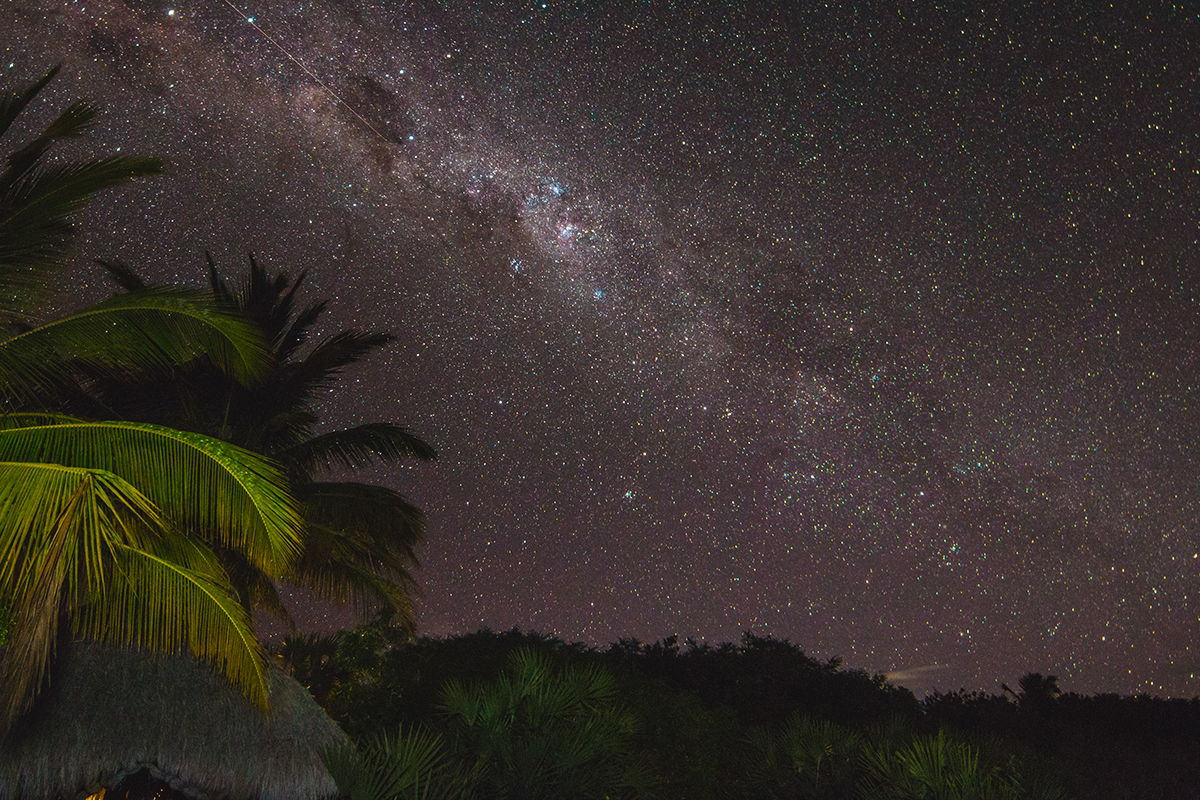
The Carina region of the Milky Way is spectacular. This photo was taken about 2 hours after sunset. The nebula Eta Carinae can be seen in the centre of the image.
After some young open clusters, my next target was one of the elder statesmen of the Milky Way. Discovered by James Dunlop in the 1820s, NGC 2808 is one of the most massive globular clusters in the galaxy, stretching more than 120 light years in diameter and containing around one million stars. Located midway between Miaplacidus (Beta Carinae) and Aspidiske (Iota Carinae), two of the four members of the False Cross, it is easy to find. I picked up the GC up using 24x, and the cluster appeared about 10’ across with a very dense core, which subtended about 1/3 of the total diameter. Taking the power up to 57x, the very centre of the cluster was an incredibly intense stellar like point, surrounded by a dense outer core, which itself was enrobed by a granulated halo. The GC appeared very condensed and this is reflected in its class I classification, which are the most highly condensed clusters. Using averted vision, I was sure I was detecting a few thin, denser patches radiating away from the outer core across the halo.
Switching back to open clusters, my next target was easily located by following the long axis of the “False Cross” south beyond star Avior (Epsilon Carinae) for about 3-degrees brought my next mark into view. Pretty obvious as a bright condensation in the Milky Way, NGC 2516 (C96) is known as the Southern Beehive due to its similarity to showpiece of Cancer. With the M44 still above the horizon (though less than 10o), but cradled in rather bright zodiacal light I was able to compare and contrast the two. M44 distinctive boxy core was obvious, surrounded by swarms and streamers of stars like bees returning from pollination. M44 is too large to be contained by anything other than my 24mm Panoptic, but its southern sibling presented a very similar view but using the 7mm for 81x rather than 24x.
Returning to the False Cross once again, my next target utilised Delta Velorum as the start point for traversing less than two degrees west to reach IC 2391 (C85), the Omicron Velorum Cluster. Named after the Beta-Cepheid type variable star, Omicron Velorum which is the brightest star in the open cluster, this magnitude +2.5 OC is visible to the naked eye as yet another bright condensation in this very busy region of sky. In the 30mm finder about a dozen tiny sparkles of light were visible. The 24mm also contained smaller open cluster NGC 2669, though it is far more distant and intrinsically larger than my latest quarry. Switching to the 10mm just about contained the cluster which extends to almost a degree across. At the centre of the cluster was a trapezium extending about 1/3 of a degree on the long axis, which amusingly did a rather good impression of the multiple star system at the heart of the Orion Nebula, thanks to some fainter stars masquerading as the “E” and “F” components of that famous grouping, just magnified to level not normally available. While virtually all the stars burned with a blazing blue-white colour, one or two members of the cluster had a subtle yellow hue to them.
One DSO I had completely forgotten about on my last trip to the southern hemisphere in 2017 was not going to be lost again among beautiful open clusters and bright nebulae, and that was NGC 3132 (C77), a bright planetary nebula in Vela known as the Southern Ring. Using magnitude +2.7 Alherem (Mu Velorum) at the top of tip of the sail of the ancient vessel, I headed south west to q Velorum. Placing this star near the field stop of the 24mm meant the Ring was just in the field, but at only 24x, this 1’x0.7’ ring appeared very stellar. Switching to the 7mm for 81x, opened up the nebula a little and revealed the magnitude +10 central star. However, that star is not hot enough to ionise the expanding shell of gas, and it is in fact a 100,000K surface temperature white dwarf, less than 2” away that is the progenitor and irradiator of the planetary. I found I was able to observe more detail still using the lower settings of my Nagler Zoom. Using 5mm, there appeared to be tiny blobs nestled around the ring, which were only visible with averted vision. Once my gaze attempted to view more closely one of these features, it would disappear and another would appear else where on the ring, such that I felt like I was chasing apparitions around for a few minutes. An impressive planetary, but this is one where the north has the better example in my opinion.
One object had been calling out to me since darkness fell, and it is extremely obvious, nestled against the bright Milky Way like a small pendent in the sky. NGC 3372 (Caldwell 92) is the most visually striking and impressive emission nebula in the sky. Dwarfing its famous Orion based cousin, M42, by more than seven times, the Carina Nebula extends more than 200 light years in diameter. This also translates into a whopping 120 arcminutes on the sky which means low power viewing is needed to take in the full splendour of this stellar nursery. Using the 24mm for a 2.7o field, multiple irregular strips of gently green-hued cloth appeared woven together using strips of black lace into a celestial blanket. Several vibrant open clusters are embedded in the glowing robes of gas and I spent some time exploring the OCs, which would be attractions to hunt down even if they were located against an empty sky.
Near the centre of the Nebula is the open cluster Trumpler 16, which extended about 10 arcminutes across and contains one of the most famous explosions in the universe, the star Eta Carinae. Using a 12” scope in Namibia at more than 300x, I was able to study the homunculus nebula which has been made so famous by the HST. However, each of the exploding lobes only measure 1’ across and I was unable to tease out any detail when I used by maximum power with my 3” scope.
Given the young age of the nebula and its embedded infant stars, it is unsurprising that almost all appear blue-white. However, two stars really drew my eye when viewing the nebula due to their extreme colour contrast, w Carinae, a magnitude +4.55 variable star which sits to the outer edge of the largest piece of the emission nebula, and u Carinae, a +3.8 star which is adjacent to the glowing gas. Both appeared bright yellow, though w is red giant and I wonder if the contrast against the green glimmering hydrogen altered my colour perception of this star.
When I was ready to move on and deciding on my next target, I leant against the scope, and its position shifted slightly west. Clearly, I had not locked down the azimuth axis. I am glad I did not. Less than two degrees from the centre of the nebula is NGC 3293, known as the Gem Cluster due to it similarity to the more famous Jewel Box (NGC 4755). Even at 24x, this tiny open cluster, stretching less than 10 arcminutes across was stunning. Almost all the cluster members burned with a bright white light, almost blindingly so. So many open clusters lack bright individual components, but here I felt you could scatter these stars around the heavens and they would act as bright markers for star-hopping astronomers. In stark contrast, one or two yellow/red stars appeared when I took the magnification to 81x. The bright blue-white stars have an age of only 6 million years. However, these dimmer red stars appear to be about 20 million years which implies star formation took a rather sedate 15 million years.
About 4o east of the Eta Carinae cluster, is yet another famous DSO and obvious brightening of the Milky Way. Lacaille included in this cluster in his 1755 catalogue, noting that many blue stars of 6th, 7th and 8th magnitude surround the bright star Theta Argus (now Theta Carinae), much like the Pleiades. Hence the nickname Southern Pleiades (IC 2602 / C102). However, unlike the Beehive’s southern equivalent, there is far less family resemblance. Spanning as much as 100’, the only EP I had that would frame it was the 24mm. At 24x there are two distinct groupings among the clusters 60 or so members. The first group includes the very interesting star Theta Carinae, with attendant mild arc of stars, and the second is separated by a fairly dark lagoon of emptiness and has a quite random arrangement of tiny suns. The cluster itself, while not being as rich as M45, has a nice trick up it’s sleeve, by sitting on top of dense field, more stars appear to be members of this cluster.
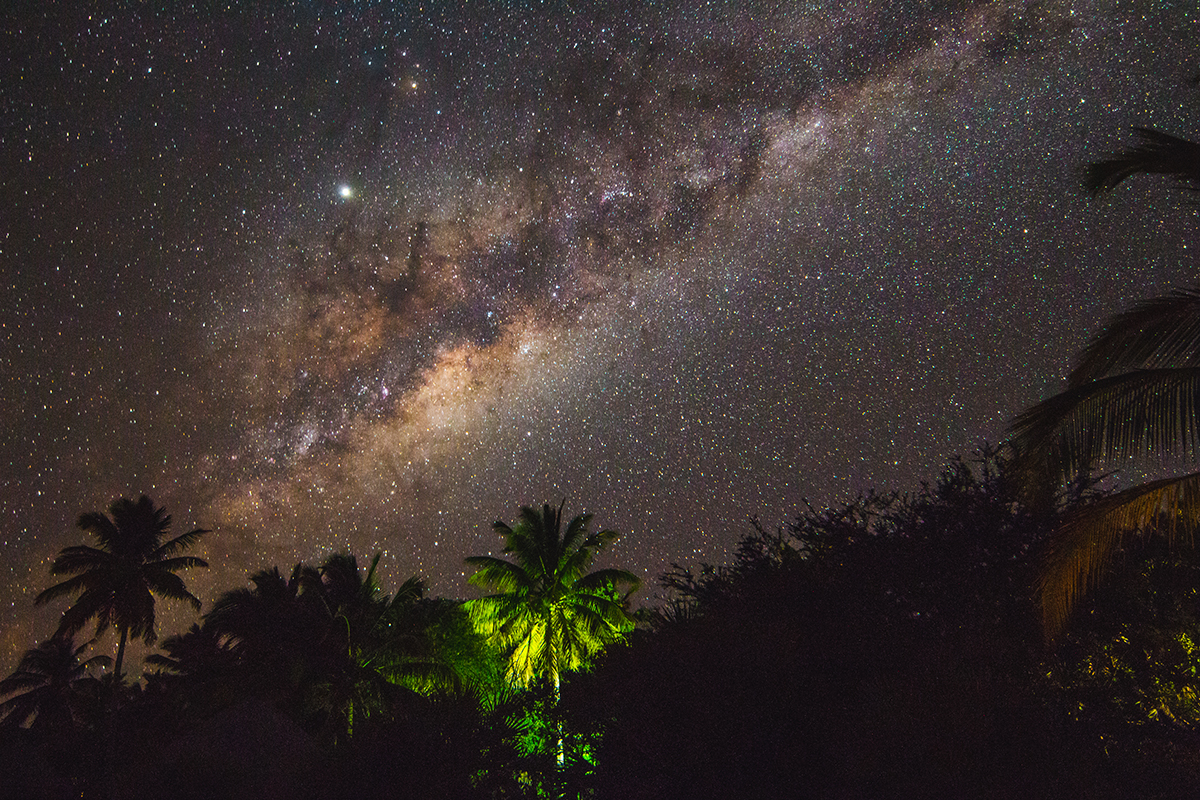
The centre of the Milky Way was still rising during this session. All the treasures within it would have to wait for another session.
Theta Cariane dominates the field and draws the eye as it is so bright at magnitude +2.7, and really is a cluster member. And this leads to a bit of an issue. It is one of the brightest cluster stars found anywhere in the night sky, and it is in fact too bright. With cluster stars all born at the same time, and evolving top-down, this 10+ solar mass star should already be a red giant, and many smaller mass stars in IC 2602 already are. The star appears far too young, just a few million years old, compared to 34 million years for the cluster as a whole. As such it is the brightest “Blue Straggler” in the sky, and is likely the result of a merger of two lower mass stars.
Having taken a showpiece whistle stop tour of Jason’s famous vessel that the Argonauts sailed aboard on their journey to retrieve the Golden Fleece, but barely scratched the surface of all the deep sky treasures contained in this massive, but now defunct constellation, I was aware there was not too much time left before I would head to the dhow bar further up to the beach for a pre-dinner G&T. However, there were just a few more objects on my target list and my next stop was to the constellation that honours Chiron, the wisest and most just of all the Centaurs and teacher to both Jason and Hercules.
First up was a DSO that has a Bayer designation. The most massive of all Milky Way globular clusters, and likely the core of a long-ago consumed dwarf galaxy, Omega Centauri is huge, both in appearance and physically. More than 10 million stars contained in a ball 150 light years in diameter, it subtends the same angular diameter as the full Moon, despite being almost 16,000 light years away. A star hop is not really needed for this one as it can be seen naked eye, but it is an easy one nonetheless, with a quick hop from Rigel Kentaurus (Alpha Centauri) to Hadar (Beta) and then North West to Birdum (Epsilon). From there less than one finder field to Omega Centauri. It was an impressive sight even in my 30mm finder, matching or exceeding the view my 3” scope has shown of many Messier globular clusters.
Starting at 24x, the cluster appeared to be made from tiny specs of slightly translucent powder, illuminated very gently from the inside. With averted vision, there appeared to be some delicate streamers of stars radiating away in multiple directions. Moving up to 81x with the 7mm Nagler really was spectacular. Now more than half the field was taken up with a giant pitted snowball which scintillated with thousands of tiny lights, especially with averted vision. One feature that really strikes me about Omega Centauri is just how uniform the brightness is across the entire face of the globular. Some GCs, show such a vivid concentration of light towards the core, you would swear a bright, solitary field star sits in front of the cluster along our line of sight. The complete opposite is true of this giant. There is virtually no rise in luminosity from edge to centre.
Changing course and leaving the Milky Way for the first and only time in this observing session, was one of the most striking and unusual galaxies to be found in the heavens. I panned north east to the star Alnair (Zeta Centauri), and then about 6o west and came straight to my target. Centaurus A (NGC 5128 / C77) is galaxy that warrants superlatives, no matter which part of the electromagnetic spectrum you happen to be observing it in, so bright is it at all wavelengths. The galaxy almost defies definition. A massive elliptical galaxy appears to be bisected by a giant dust lane. At 81x, it really took on the appearance of a hamburger (making me hungry for dinner). The two halves of the bright halo are amorphous as with all elliptical galaxies, but there were tantalising hints of structure and twists in the dark lane, with dark, dusty, streams of material appearing peel away from the ball of stars into interstellar space. It has definitely become one of my favourite galaxies to view since first observing it with a 12” in Namibia in 2016 and it never disappoints, regardless of aperture.
Departing the Centaur for now, my last object of this short 2-hour session was NGC 4755, known as the Jewel Box in Crux. Herschel suggested that when viewing the cluster through a scope of sufficient aperture to reveal the colours of the constituent cluster members, that it took on the appearance of a piece of fancy jewellery, and from there the name stuck. Incredibly easy to locate, the cluster lies less than one degree from Becrux (Beta Crucis), the east most star in the famous cross which adorns so many flags of countries below the equator. Using 81x, I placed Becrux in the field and then slide over to centre the Jewel Box. The four brightest cluster members are arranged in a triangle and dominate the field, superimposed on a dimmer, but still impressive second cluster more numerous in nature. Most of the stars appeared like blue sapphires, but a couple really contrasted with a red ruby near the centre in the form of Du Crucis, a giant star 330 times the diameter of the Sun, and a yellow topaz, supergiant B3Ib star HD111990 on the periphery.
After enjoying the exquisite celestial jewels, I quickly packed down the scope and took it inside our Casinha, and headed up the beach for the much earned G&T at the dhow bar before a wonderful three-course meal prepared by Vic and his kitchen team. I was certainly pleased with the amount of stargazing I had achieved on our first night on the island, knowing I had several more days before a waxing crescent Moon would start to rob this part of the sky of its radiant splendour.






